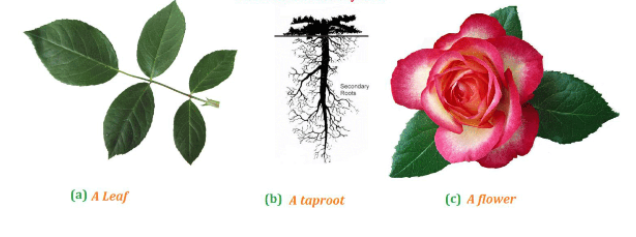NCERT Solutions for Class 6 Science Chapter 7 Getting to Know Plants
Question 1. Correct the following statements and rewrite them in your notebook.
(a) Stem absorbs water and minerals from the soil.
(b) Leaves hold the plant upright.
(c) Roots conduct water to the leaves.
(d) The number of petals and stamens in a flower is always equal.
(e) If the sepals of a flower are joined together, its petals are also joined together.
(f) If the petals of a flower are joined together, then the pistil is joined to the petal.
Answer:-
(a) Roots absorb water and minerals from the soil.
(b) Stem hold the plant upright.
(c) Stem conducts water to the leaves.
(d) The number of petals and sepals in a flower is usually equal.
(e) If the sepals of a flower are joined together, its petals are not necessarily joined together.
(f) If the petals of a flower are joined together, then the pistil is not necessarily joined to the petal.
Question 2. Draw (a) a leaf, (b) a taproot and (c) a flower, you have studied for Table 7.3.
Answer:-

Question 3. Can you find a plant in your house or in your neighborhood, which has a long but weak stem? Write its name. In which category will you place it?
Answer:- Yes, money plant in our house. It is a climber.
Question 4. What is the function of a stem?
Answer:- The function of a stem are:-
(i) It hold the plant upright.
(ii) It transports water and food from one part to different parts of the plant.
(iv) It hold branches leaves, flowers and fruits.
Question 5. Which of the following leaves have reticulate venation? Wheat, tulsi, maize, grass, coriander (dhania), China rose.
Answer:- Among these tulsi, china rose and coriander leaves have reticulate venation.
Question 6. If a plant has fibrous root, what type of venation do its leaves have?
Answer:- If a plant has fibrous root, its leaves must have parallel venation.
Question 7. If a plant has leaves with reticulate venation, what kind of roots will it have?
Answer:- If a plant has leaves with reticulate venation, it definitely will have tap root.
Question 8. Is it possible for you to find out whether a plant has taproot or fibrous roots by looking at the impression of its leaf on a sheet of paper?
Answer:- Yes, it is possible to find out whether a plant has taproot or fibrous roots by looking at the impression of its leaf on a sheet of paper.
Question 9. What are the parts of a flower.
Answer:- The parts of a flower are following:-
- a) Sepals
- b) Petals
- c) Stamens
- d) Pistil
Question 10. From the following plants, which of them have flowers?
Grass, maize, wheat, chilli, tomato, tulsi, peepal, shisham, banyan, mango, jamun, guava, pomegranate, papaya, banana, lemon, sugarcane, potato, groundnut.
Answer:- I have seen all of them and each of the above mentioned plant have flowers.
Question 11. Name the part of plant which produces food. Name the process.
Answer:- Leaves produce food by the process called photosynthesis.
Question 12. In which part of a flower, you will find the ovary?
Answer:- We will find ovary in pistil.
Question 13. Name two plants in which one has joined sepals and the other has separate sepals.
Answer:- Flowers with joined sepals:
(i) Datura (ii) Loki
Flowers with separate sepals:
(i) Gurhal (ii) Mustard
Click on the Chapter’s Link to get PDF of all Chapters of NCERT of Science Class 6
Get NCERT Solutions for Class 6 Science Here
- Chapter 1 Food: Where Does it Come From?
- Chapter 2 Components of Food
- Chapter 3 Fibre to Fabric
- Chapter 4 Sorting Materials into Groups
- Chapter 5 Separation of Substances
- Chapter 6 Changes Around Us
- Chapter 7 Getting to Know Plants
- Chapter 8 Body Movements
- Chapter 9 The Living Organisms Characteristics and Habitats
- Chapter 10 Motion and Measurements of Distances
- Chapter 11 Light, Shadows and Reflections
- Chapter 12 Electricity and Circuits
- Chapter 13 Fun with Magnets
- Chapter 14 Water
- Chapter 15 Air Around Us
- Chapter 16 Garbage in, Garbage out